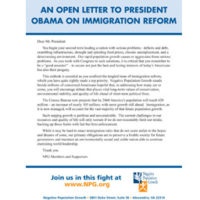Little Known Presidential Population Leadership
- Otis L. Graham, Jr
- January 19, 2013
- Forum Papers
- Forum Paper
- 0 Comments
One more president was then added, like the others cautiously nervous that “overpopulation” concerns might be politically hazardous. In 1969 newly elected President Richard Nixon’s Aide Daniel P. Moynihan convinced his boss to take what could have been the largest (yet) presidential step on the population growth question. Nixon agreed to appoint (as we have seen) a Commission on Population Growth and the American Future, chaired by John D. Rockefeller III, and sent a special population message to Congress.
Four presidents now had cautiously explored demographic strategies for winning the global struggle against communism and for environmental protection – restraining population growth. The Rockefeller group’s document was the boldest “report” of any the presidents had commissioned, for it discovered that immigration at the end of the l960s was bringing in 400,000 new Americans a year (this was an undercount), or 25% of our annual growth. Clearly, a stable population would require lower levels of immigration, a discovery that came just seven years after Congress ill-advisably passed a major immigration expansion in 1965.
Nixon, believing himself threatened with political reprisals by the Catholic hierarchy overseas, decided that “birth control” might be politically toxic to a significant portion of the American electorate, and declined to receive the report, fatally undermining his own leadership claims. The report was widely circulated and discussed, but not from the Bully Pulpit.
Now we can count four presidents as active in policy exploration engaging “the population problem” – then five, when Nixon in April, 1974, ordered a study of the national security implications of population growth. When the report (National Security Study Memorandum 200) arrived in the Oval Office in 1975 the president behind the desk was Gerald R. Ford, who endorsed the findings of NSSM and called for the U.S. to exert world leadership in population control, including stabilization of our own population by 2000. President #5.
Quickly came #6, when President Jimmy Carter in May, 1977 launched a joint Council on Environmental Quality and State Department inquiry which published at the end of 1980 Global 2000. “Environmental problems do not stop at national boundaries,” it began, and then concluded: If present trends continue, the world in 2000 will be more crowded, and more vulnerable to disruption than the world we live in now. Serious stresses involving population, resources, and environment are clearly visible ahead. Despite greater material output, the world’s people will be poorer in many ways than they are today.
Graham was Professor Emeritus of history at the University of California, Santa Barbara. He was the author or editor of more than fifteen books, including “Debating American Immigration, 1882-Present” (with Roger Daniels) and “Environment Politics and Policy, 1960s to 1990s”.

